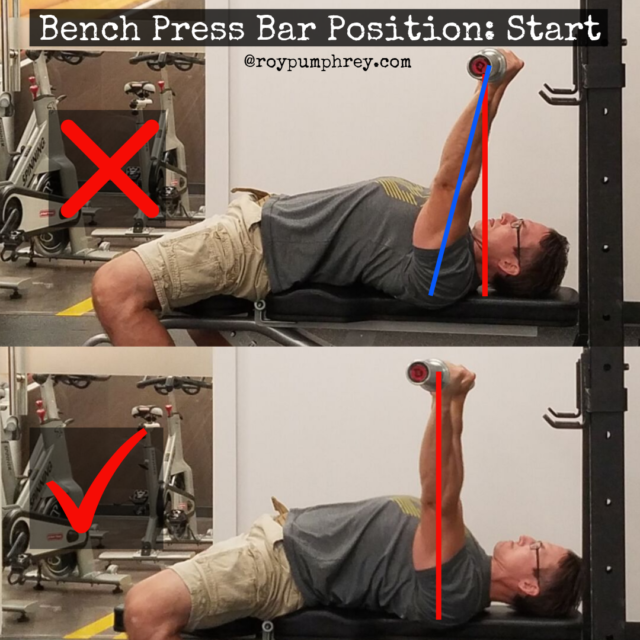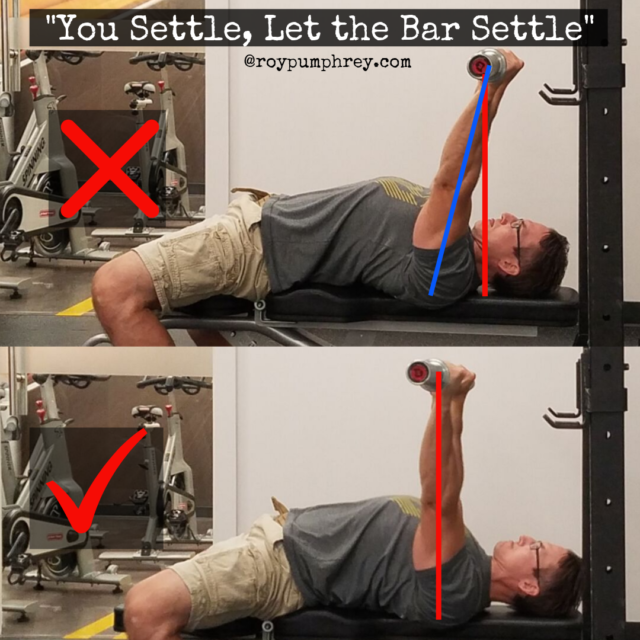The #1, post Beginner phase, Mistake Lifters (still) Make?
Rushing The Rep
They don’t set up with intention, unrack the weight “tight”, allow the weight to settle, compress the joints and “feel” the weight before performing the movement.
Weights get a little heavy, the set gets a little hard and we start to think,
“If I go fast, i’ll get in and out, and don’t have to hold the weight any longer than is absolutely necessary”
This probably happens for a few reasons:
Figured out the Stretch Reflex.
Sooner or later you’ve discovered the “bounce” or “rebound” you can get out the the bottom of a squat or bench.
Not in a, crash the bar into your chest and heave it off type of way.
But a, if I go fast and time it right, I can get a sling shot effect out of the bottom, type way.
That, my friends, it the stretch reflex or plyometric response in effect.
So you hurry up and rush the rep in a hopes of maximizing this effect.
When the sh@t gets heavy, every bit of extra help…can help.
Afraid They’ll Gas Out.
If you lift weights with any real intent for more than usually 6 months to a year, you’ll finally encounter an actually heavy weight.
See, when people pick up a weight and, while holding it, tell you how heavy it is…
It’s not Heavy
In fact, it’s probably pretty light.
They just suck at lifting and don’t know what real HEAVY is yet.
Eventually, you’ll learn, progress, and lift something that has some real weight to it takes REAL effort and you’ll learn.
Lifting Max Weights Takes a LOT out of you.
You see the problem with heavy weights is,
They’re Heavy
So, I think, people try to set up and go fast so they don’t have to be in contact with the weights any longer than necessary.
Basically, get in- get out.
And if that means rushing the rep, that’s 100% the WRONG thing to do.
Wait, But What?
While you don’t want to purposefully go slow and hold the bar longer than necessary for no reason, you do want to be mindful and deliberate about your process.
When the weights get heavy you need to SLOW DOWN YOUR PROCESS.
Be MORE deliberate about your setup. <—-If your set up sucks you have severely limited your chance at a successful lift. Set up is INCREDIBLY important.
“Be Quick, But Don’t Rush” – John Wooden
The “Lift” starts the minute you approach the bar.
That means your hand placement needs to be locked in.
Foot placement locked in.
Back tight (shoulders packed and lats locked in)
“Like all other phases, it is crucial to create as much tightness as possible. This means pulling the shoulder blades together and engaging the lats while squeezing the bar. Experimenting with elbow position (forward or backward) can also help create a more stable shelf for the bar.” – Blaine Sumner on setting up to squat
Core Bracing SET. <—-this includes 360 degree belt pressure.
Being in place to PERFECTLY/ Efficiently unrack the bar
The Art of Unracking
The Squat?
Don’t squat the bar out of the rack!
Performing a quarter squat or good morning to get the bar out of a rack (when you don’t have to) is wasting energy and complicating your setup.
*some racks don’t give you much of a choice, when in doubt set the j-hooks lower and get squatty rather than higher and have to go on the toes.
Instead, after crushing the bar, tightening the upper back and pulling the bar as deep into your traps as you possibly can, slightly “arch”/ press the hips forward to clear the J-Hooks..
“Often with unracks people tend to waste a lot of energy getting the bar out of the rack. A big part of making this more efficient is making sure your rack height is set high enough so that all you have to do to unrack the bar is slightly thrust your hips forward, but not too high that you end up clipping the rack. If you set the rack height too low, you’re basically doing a partial squat before your actual squat, and why waste the energy?” – Derrington Wright
This helps make the “walk back” MUCH easier because you’re standing taller.
The chest is up and the hip, knee and ankle joint are more stacked, shortening any possible lever arms.
This way you’ll have a better chance of limiting and bracing against the bar whip helping to minimize extra movement and conserve energy as you set up.
Trying to stop and brace against a whipping 400lbs bar takes a lot of energy/ strength.
The Bench?
Press the shoulders down into the bench as hard as possible, this should automatically extend/ straighten the elbows.
While pressing the shoulders down PULL/ SCRAPE the bar out of the J-hooks
WITH THE LATS
WITH THE LATS
WITH THE LATS
Like in a straight arm lat pulldown.
Doing this helps maintain shoulder packing and back tightness.
“One of the biggest mistakes you can make is to try and lift the bar out of the rack. If you do that, your shoulder blades will rotate out and pull apart, and you’ll lose all your tightness. Once you have the weight out, there’s no way in hell you’ll be able to put them back in position again. My solution is to have your spotter help you pull the bar out of the rack. Roll the bar forward, take a deep breath, fire your lats, and pull.” – Dave Tate
Contrary to what seems to be going around the internet at the minute,
YES, the LATS are important in the bench press.
Both raw and equipped.
Sure they may not be primary movers of the bar, but the tighter your upper back and lats are while bench pressing:
- The better “base” you have to press off of.
- The safer your shoulders will be
- More control over the bar and the bar path you’ll have.
Appeal to authority or the “Because he played fallacy” is usually a really bad reason to do something but virtually EVERY BIG BENCHER EVER says you need at least adequate lats to stay healthy and press big so maybe there is at least something to it.
Pull the bar OVER the shoulders/ upper chest.
“I think we all realize this when we’re holding the bar at lockout. It’s a lot easier to hold the bar directly over your shoulders than it is to hold the bar over your sternum or your upper stomach, for example. The exact same principle applies at every other point in the lift.” – Greg Nuckols
This goes for the face too.

Pull the bar out until it’s over your shoulders/ upper chest.
The bar should be vertical, a perfect 90 degrees to the floor.
go to 2:12, watch and listen (the whole video is worth your time)
How Will I Know?
The Bar Will Feel (Almost) Weightless
But not really.
Yes, it’ll still be heavy.
But, if you stay packed (shoulders tight, lats tight, elbows straight, wrist straight, crushing the bar), the bar itself will suddenly feel MUCH LIGHTER when the arms are perfectly vertical relative to the ground.
“Hold- HoLD – HOLD!!!”
Here’s were you need to grow some balls really be disciplined.
STAND in the squat, HOLD the bar in the bench and ALLOW the bar STOP MOVING and let it CRUSH YOU.
Lifting heavy weights is hard enough.
It’s MUCH HARDER to control the bar and maintain the bar path you want when the bar is already moving and whipping before you even start your lift.
“This is a very simple concept but it’s very seldom practiced. Most lifters will unrack the bar and lower it to the chest without setting the bar first. This is usually done by habit and will cause you to lower the bar in a diagonal pattern that will result in you pushing it back up in the same pattern.” – Dave Tate
Get that bar to settle and be as motionless as possible.
Pay attention to the bar whipping, especially after the first rep.
too many breaths for my liking, but when you squat a grand and set a WR, you can do whatever you want.
See the common theme here after they get their stance?
THEY LET THE WEIGHT SETTLE
Holding the bar will also compress your joints together.
And this is a good thing.
It’ll help “stack” your joints, increase the pressure in the system as a whole and tighten you up.
Rules, there’s always Rules
Actually, there is only one rule.
NEVER LOSE TIGHTNESS
Set up, unracking and settling the bar is not a time to rest.
Or get psyched up and say some frat boy, supposedly motivational, bullshit. #getsome #beastmode <—you shouldn’t be talking/ making noise as it is….
It’s a time to try and get TIGHTER.
Once you unrack that bar you can not get as tight as possible again.
The best you can do is maintain as much tightness/ bracing as possible from the start.
“if you don’t set your brace before unracking, it’ll be almost impossible to do so when already under load.”- Derrington Wright
That said, you NEED to TRY and continue to create more tension in the system.
That’s the only way to keep the most tension in the system possible.
Fundamentally, keeping tightness, is exactly why you MUST hold the weight and allow it to compress you.
“If you want to bench heavy weight and blow past any sticking point, there’s a position you absolutely must get your body into every time you bench. The key is tightness, and without this stable position, technique will crumble.” – Dave Tate
Without maximal tightness/ tension in the system you decrease the force transfer through the bar because of force leaks that will occur during the lift.
This will almost always result in missed lifts and an increased risk for injury under max and near max loads.
How Do I Know If I’m Tight?
Easy, unrack an EMPTY BARBELL, get into position and have someone push on you.
If you move/ lose position/ sway at all,
You’re NOT Tight Enough
Once you get “solid” enough, try doing this drill with a loaded bar.
To put it another way, there should be so much tension in the system that just to hold your bench or squat setup for more than 30 seconds is unbelievably uncomfortable and causes cramping.
Now, keep that tension.
Every muscle tight, the whole lift.
Let the bar settle and compress you.
“You settle, let the bar settle”
Keep that tightness.
No breathing out, words, noise, extra movement.
Just force through the bar.
That’s being tight.



